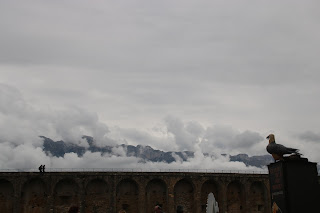Sobre los años 1920 se quiso dar un impulso en la zona de Moncayo. Se intentó varias veces impulsar el proyecto, hasta que en 1927 el ministerio de fomento del 4 de agosto de 1927 se declaró a Moncayo Sitio Natural de Interés Nacional de la Dehesa del Moncayo.
En 1934, durante la Segunda República, se cedieron al ayuntamiento de Tarazona unas 40.000 hectáreas de terreno para la construír la Ciudad Montaña de Agramonte, en la que irían ubicados un sanatorio, un hotel y colonias escolares, aunque el proyecto se paralizó en la guerra y se retomo después de la misma.
El primer edificio que se empezó a levantar fue el hotel.
Al estallar la Guerra Civil el edificio se abandonó. En mayo de 1938, se inauguró el sanatorio anti tuberculosis en manos del ministro General Martínez Anido.En agosto llegaron al sanatorio las Hermanas de la Caridad de Santa Ana para formar el sanatorio de Agramonte. El sanatorio daba servicio a quienes no podían pagarse el tratamiento.En un principio solo se trataba a mujeres y niños, aunque más tarde empezaron a tratar también a hombres.
El sanatorio cerró el 30 de septiembre de 1978 ya que la tuberculosis entraba ya en la Seguridad Social.
The antituberculous sanatorium of Agramonte, is an old preventorio located in the skirts of the mount Moncayo (province of Zaragoza).
About the 1920s, an impulse was sought in the area of Moncayo. Attempts were made several times to promote the project, until in 1927 the Ministry of Development of August 4, 1927 declared itself a Natural Site of National Interest of the Dehesa del Moncayo.
In 1934, during the Second Republic, some 40,000 hectares of land were transferred to the municipality of Tarazona to build the Mountain City of Agramonte, where a sanatorium, a hotel and school colonies would be located, although the project was halted in the war and resumed after it.
The first building that began to be built was the hotel.
When the Civil War broke out the building was abandoned. In May 1938, the anti-tuberculosis sanitarium was inaugurated by Minister General Martínez Anido. In August, the Sisters of Charity of Santa Ana arrived at the sanatorium to form the sanctuary of Agramonte. The sanitarium was serving those who could not afford the treatment. Initially, only women and children were treated, although later they also began treating men.
The sanatorium closed on September 30, 1978 as tuberculosis was already entering Social Security.




















































